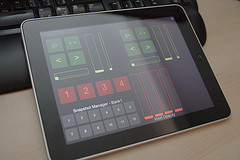Well, I suppose I'm not skeptical about the potential, but rather many of the initiatives - you've probably seen some yourself. They go along the lines of, "Wow, look, we're buying all students an iPad. Aren't we fantastic."
Some people actually think simply buying the devices will revolutionise learning and teaching, or magically solve student satisfaction for NSS. Well, I hate to burst the bubble, but they won't!
You see, you can't throw money at a problem and expect it to go away. Just as you can't cover up a rotten building with some fresh plaster board, you similarly can't easily renovate fundamental problems in HE by dishing out iPads. Instead, just as a building project needs expert review and planning (in the shape of architects, builders and interior designers), so to does educational renovation (in the shape of academic rationale, strategic planning and learning technologist support).
Now iPads do have potential, a lot of it. But please think about what they will be used for before buying them.
Here at MMU there has been an interesting project in Health where students were handed iPads during classes to follow along with slides and access specific links, which then served as the spark for in-class discussions and problem solving. Early feedback suggests students really enjoyed this type of work, as they were more active in the class opposed to traditional passive approaches. Keep an eye out for Hannah Crumbleholme doing the conference circuit on this...
And this is only the beginning. There are a range of dedicated apps to support learning and teaching. There are History apps, Astronomy apps, Anatomy and Physiology apps, and a range game-based learning apps. iPadsInEducation is an interesting site that recommends apps based on subject areas. And then there's the potential of iTunesU - something I also mentioned as part of my post on the Open Content Movement.
I also recently came across the Socrative Teacher app; a great looking 'Smart Student Response System' that might replace clickers/voting response systems.
Unfortunately, there is no particularly good iPad app for the version of Moodle we run here at MMU (1.9), but there is for Moodle 2.0 onwards - something we'll likely benefit from next year. Other VLE's such as Blackboard, have great dedicated apps for mobile learning, which enable learners to access content, videos, and engage in discussions, blogs, etc.
Other interesting stories related to iPads include a recent article highlighting an Air Force are ditching paper manuals in favour of iPads, or The School that Gives all Students an iPad. A sign of the times?
What do I use?
I bought the original iPad on the day it came out, and despite being an Apple fan boy, I see no reason to upgrade to the iPad 2, or The New iPad. Sure the graphics, memory and screen are much improved, but they were pretty decent to start out with, and more than sufficient for how I use it.
So how do I use it? Well;
- I have the Reader and Flipboard apps which allow me to view the range of RSS subscriptions (blogs and journals generally).
- Evernote is a great app for taking notes in meetings (or lectures) and syncs with the desktop (and iPhone) counterparts. You can even take photos and search the text within them, say, of whiteboards and flip charts, etc.
- Dropbox is another must-have. I have tons of files in dropbox which syncs across computeres, laptops, and mobile devices, and accessible on my iPhone and iPad.
- Goodreader has proven very useful for reviewing files like journal articles. It syncs with Dropbox and enables highlighting and commenting on PDF files.
- Blogger, well, to blog :-)
- TED offers a wealth of videos from thought leaders to get you thinking - perfect for train journeys or when you have a few minutes to spare.
- eReader apps such as iBooks and Amazon Kindle, which are great for reading electronic text books.
- The built in Reminder app is great as it syncs with my Mac Mail/Calendar accounts
- In terms of editing documents, you obviously have Apple's own apps such as Pages and Keynote, but I have recently stumbled upon CloudOn, a handy tool for syncing with Dropbox (and other services) and editing word/excel files.
The list could go on and on - detailing apps, methods and workflows that have transformed my daily routines, but I'll hand over to you. What apps do you use, or are you involved in an iPad Project involving students? Answers on a postcard...
Image of iPad licensed under CC-BY from Flickr user Jaymis

This work by Peter Reed is licensed under a Creative Commons Attribution-NonCommercial 3.0 Unported License.




